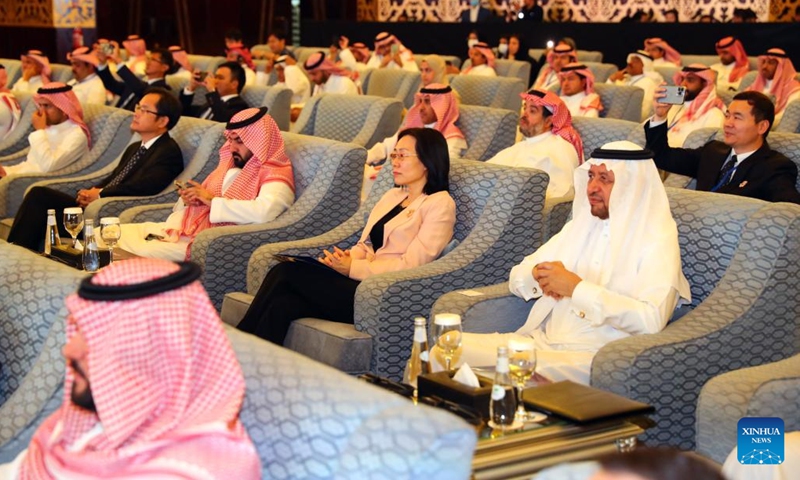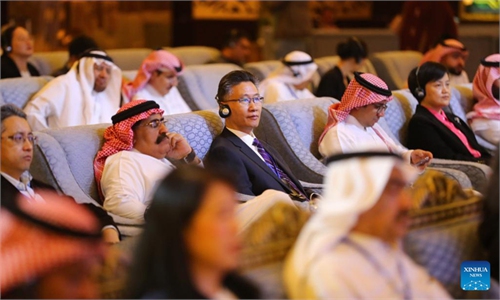From Arab-style headscarves to infrastructure, Chinese products welcomed in Arab countries

Guests attend the 2022 Chinese-Arab Media Cooperation Forum in Riyadh, Saudi Arabia, Dec. 5, 2022. The forum, co-sponsored by the China Media Group (CMG) and Saudi Arabia's Ministry of Media, gathered more than 150 government officials, representatives of media organizations, and scholars from China and 22 Arab countries.(Photo: Xinhua)
From the Lusail Iconic Stadium built by a Chinese company to the opening of direct shipping between China and Sudan, the layout of China's joint construction under the Belt and Road Initiative (BRI) with Arab countries has continued to improve, according to the spokesperson.
Mao’s remark was made in response to the newly signed memorandum of understanding between China and Palestine on the joint construction of the BRI as the high-quality development of the initiative continues to go deeper.
China has signed BRI cooperation documents with 21 Arab countries and the League of Arab States.
Industry representatives told the Global Times on Thursday that their business in Arab markets is seeing a strong momentum for growth.
In the Wujiang district of Suzhou, East China’s Jiangsu Province, producers are working around the clock to make Arab-style headscarves.
"Orders were placed ahead of the Spring Festival, mainly for Arab-style headscarves...the annual sales volume is expected to amount to 30 million yuan ($4.3 million) this year, a year-on-year increase of about 20 percent,” Sheng Xinjiang, president of the Turban Textile Chamber of Commerce in Wujiang district, who is also the owner of a local turban company, told the Global Times on Thursday.
Since the 1990s, when Saudi Arabian clothing company Ajlan & Brothers invested and opened the first Arab hijab enterprise in the region, the export volume of the Arab-style headscarf in the region has accounted for over 70 percent of the country, becoming a well-known industrial cluster, according to Sheng.
Using technology, automation and branding, the local companies' products have gained rising popularity in Arab countries and beyond, Sheng said.
As a world hub connecting the continents of Asia, Europe and Africa, Saudi Arabia is developing a global trade hub, and Chinese companies have played an important part.
For example, the construction of marine facilities for the mega-shipyard King Salman International Complex, developed by PowerChina, is the cash exchange project with the largest bidding amount since the establishment of PowerChina.
The project integrates ship and drilling platform manufacturing, maintenance, repair and the overhaul of supertankers. It will become the largest "super shipyard" in the world, PowerChina said in a statement sent to the Global Times on Thursday.
It will create 80,000 jobs, and is expected to increase Saudi GDP by $17 billion and save imports of $12 billion, becoming a powerful new engine for Saudi economic and social development, the company said.
This is just the tip of the iceberg for the Chinese infrastructure company in the region. Having accumulated more than a decade of experience of intensive development in Saudi Arabia, PowerChina has participated in 35 projects with a contract value of nearly $19 billion, mainly involving infrastructure and the energy projects.
The growth of China-Arab two-way investment and economic and trade is proof of the vitality of China-Arab pragmatic cooperation.
In 2021, the stock of China-Arab two-way direct investment reached $27 billion, up 2.6 times from a decade earlier. Total trade reached $330.3 billion, up 1.5 times, while bilateral trade in the first three quarters of 2022 reached $319.30 billion, up 35.28 percent year-on-year, Xinhua News Agency reported.
The advancement of the BRI has brought closer economic and trade relations between China and Arab countries, the two sides having strong complementarity in terms of investment and trade, Yan Wei, professor with the Institute of Middle Eastern Studies of Northeast University, told the Global Times on Thursday.
“The manufacturing industry in Arab countries is relatively backward. China’s exports to countries in the region are mainly mechanical and electrical products and light industrial goods. These products have certain advantages in the Arab market due to their high quality and cost-effectiveness,” Yan said.
Energy trade between China and Arab countries can help China further stabilize its energy security.
In line with the sustainable development strategy advocated by the region, China's emphasis on green and sustainable development is highly consistent with future Arab cooperation, not just in terms of new energy development but artificial intelligence, big data, automation and digital finance, the expert said.

